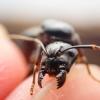So, to start off, I have had this queen since March 23, and because she has not been heated (no heating cable ![]() ), does she now only have a 4rth instar larva. I have her housed in a Mini-Hearth, in which she has laid lots of eggs, and, as she has been hiding in the area where the nestmate plugs in, I have not been able to track their development. It was not until just a few minutes ago that I saw this large larva, about the size of an Argentine ant, slightly longer. It was because of this that I did not make a journal, for fear that she would be infertile, even having been collected under a concrete slab. This concrete slab being at my uncle's wedding. I have, however, solved the not being heated problem by placing her atop my X-box, which constantly emits heat. I will next update this when the larva pupates, which, by my estimates will be fairly soon. Pictures will come with workers. I know that, according to Antmaps, C. discolor is uncommon in California, but the coloration and size fits perfectly, when I post pictures, I will start an ID thread.
), does she now only have a 4rth instar larva. I have her housed in a Mini-Hearth, in which she has laid lots of eggs, and, as she has been hiding in the area where the nestmate plugs in, I have not been able to track their development. It was not until just a few minutes ago that I saw this large larva, about the size of an Argentine ant, slightly longer. It was because of this that I did not make a journal, for fear that she would be infertile, even having been collected under a concrete slab. This concrete slab being at my uncle's wedding. I have, however, solved the not being heated problem by placing her atop my X-box, which constantly emits heat. I will next update this when the larva pupates, which, by my estimates will be fairly soon. Pictures will come with workers. I know that, according to Antmaps, C. discolor is uncommon in California, but the coloration and size fits perfectly, when I post pictures, I will start an ID thread.
Edited by NickAnter, February 3 2021 - 11:17 AM.



















